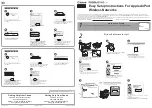
SCALANCE W1750D UI
Configuration Manual, 02/2018, C79000-G8976-C451-02
327
AP-VPN Deployment
20
20.1
Understanding AP-VPN Architecture
The AP-VPN architecture includes the following two components:
●
APs at branch sites
●
Controller at the datacenter
The master AP at the branch site acts as the VPN endpoint and the controller at the
datacenter acts as the VPN concentrator. When an AP is set up for VPN, it forms an IPsec
tunnel to the controller to secure sensitive corporate data. IPsec authentication and
authorization between the controller and the APs are based on the RAP whitelist configured
on the controller
Note
Only the master AP in an AP cluster forms the VPN tunnel.
From the controller perspective, the master APs that form the VPN tunnel are considered as
VPN clients. The controller terminates VPN tunnels and routes or switches the VPN traffic.
The AP cluster creates an IPsec or GRE VPN tunnel from the VC to a Mobility Controller in a
branch office. The controller only acts as an IPsec or GRE VPN endpoint and it does not
configure the AP.
AP-VPN Scalability Limits
The controller scalability in AP-VPN architecture depends on factors such as IPsec tunnel
limit, Branch ID limit, and datapath route table limit. The following table provides the AP-VPN
scalability information for various controller platforms:
Table 20- 1 AP-VPN Scalability
Platforms
Branches
Routes
L3 Mode Users NAT Users
Total L2 Users
3200
1000
1000
N/A
N/A
64,000
3400
2000
2000
64,000
3600
8000
8000
64,000
M3
8000
8000
64,000
7210
8000
8000
64,000
7220
16,000
16,000
128,000
7240
32,000
32,000
128,000
●
Branches—The number of AP-VPN branches that can be terminated on a given controller
platform.
●
Routes—The number of L3 routes supported on the controller.
















































